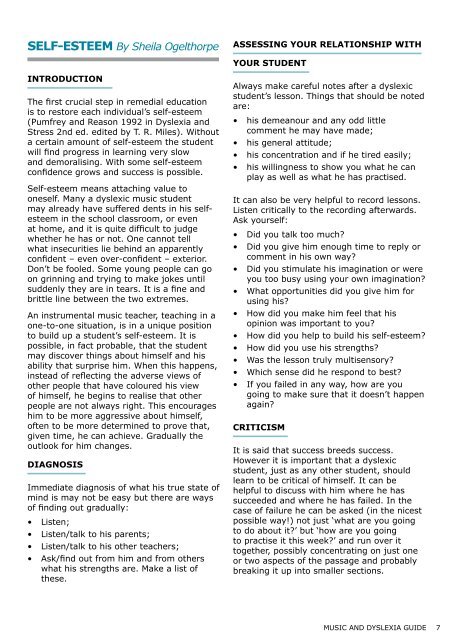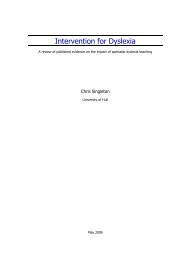TEACHER GUIDE TO MUSIC AND DYSLEXIA - Rhinegold Publishing
TEACHER GUIDE TO MUSIC AND DYSLEXIA - Rhinegold Publishing
TEACHER GUIDE TO MUSIC AND DYSLEXIA - Rhinegold Publishing
Create successful ePaper yourself
Turn your PDF publications into a flip-book with our unique Google optimized e-Paper software.
Self-esteem By Sheila OgelthorpeIntroductionThe first crucial step in remedial educationis to restore each individual’s self-esteem(Pumfrey and Reason 1992 in Dyslexia andStress 2nd ed. edited by T. R. Miles). Withouta certain amount of self-esteem the studentwill find progress in learning very slowand demoralising. With some self-esteemconfidence grows and success is possible.Self-esteem means attaching value tooneself. Many a dyslexic music studentmay already have suffered dents in his selfesteemin the school classroom, or evenat home, and it is quite difficult to judgewhether he has or not. One cannot tellwhat insecurities lie behind an apparentlyconfident – even over-confident – exterior.Don’t be fooled. Some young people can goon grinning and trying to make jokes untilsuddenly they are in tears. It is a fine andbrittle line between the two extremes.An instrumental music teacher, teaching in aone-to-one situation, is in a unique positionto build up a student’s self-esteem. It ispossible, in fact probable, that the studentmay discover things about himself and hisability that surprise him. When this happens,instead of reflecting the adverse views ofother people that have coloured his viewof himself, he begins to realise that otherpeople are not always right. This encourageshim to be more aggressive about himself,often to be more determined to prove that,given time, he can achieve. Gradually theoutlook for him changes.DiagnosisImmediate diagnosis of what his true state ofmind is may not be easy but there are waysof finding out gradually:• Listen;• Listen/talk to his parents;• Listen/talk to his other teachers;• Ask/find out from him and from otherswhat his strengths are. Make a list ofthese.Assessing your relationship withyour studentAlways make careful notes after a dyslexicstudent’s lesson. Things that should be notedare:• his demeanour and any odd littlecomment he may have made;• his general attitude;• his concentration and if he tired easily;• his willingness to show you what he canplay as well as what he has practised.It can also be very helpful to record lessons.Listen critically to the recording afterwards.Ask yourself:• Did you talk too much?• Did you give him enough time to reply orcomment in his own way?• Did you stimulate his imagination or wereyou too busy using your own imagination?• What opportunities did you give him forusing his?• How did you make him feel that hisopinion was important to you?• How did you help to build his self-esteem?• How did you use his strengths?• Was the lesson truly multisensory?• Which sense did he respond to best?• If you failed in any way, how are yougoing to make sure that it doesn’t happenagain?CriticismIt is said that success breeds success.However it is important that a dyslexicstudent, just as any other student, shouldlearn to be critical of himself. It can behelpful to discuss with him where he hassucceeded and where he has failed. In thecase of failure he can be asked (in the nicestpossible way!) not just ‘what are you goingto do about it?’ but ‘how are you goingto practise it this week?’ and run over ittogether, possibly concentrating on just oneor two aspects of the passage and probablybreaking it up into smaller sections.<strong>MUSIC</strong> <strong>AND</strong> <strong>DYSLEXIA</strong> <strong>GUIDE</strong> 7









